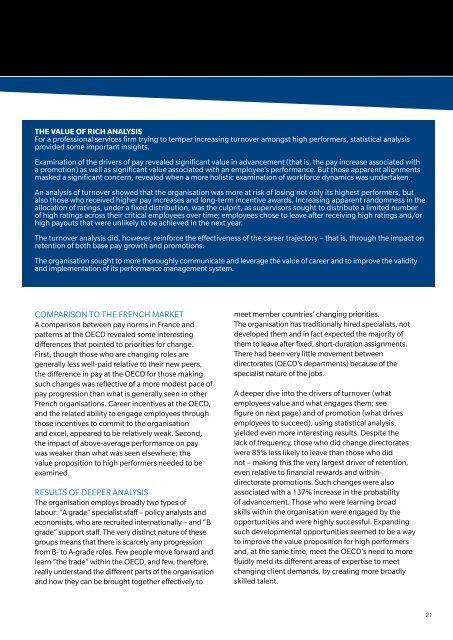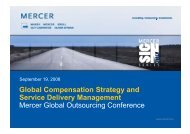A SERIES OF ARTICLES FRoM THE 2011 EMEA CoMPENSATIoN ...
A SERIES OF ARTICLES FRoM THE 2011 EMEA CoMPENSATIoN ...
A SERIES OF ARTICLES FRoM THE 2011 EMEA CoMPENSATIoN ...
Create successful ePaper yourself
Turn your PDF publications into a flip-book with our unique Google optimized e-Paper software.
<strong>THE</strong> VALUE <strong>OF</strong> RICH ANALYSIS<br />
For a professional services firm trying to temper increasing turnover amongst high performers, statistical analysis<br />
provided some important insights.<br />
Examination of the drivers of pay revealed significant value in advancement (that is, the pay increase associated with<br />
a promotion) as well as significant value associated with an employee’s performance. But those apparent alignments<br />
masked a significant concern, revealed when a more holistic examination of workforce dynamics was undertaken.<br />
An analysis of turnover showed that the organisation was more at risk of losing not only its highest performers, but<br />
also those who received higher pay increases and long-term incentive awards. Increasing apparent randomness in the<br />
allocation of ratings, under a fixed distribution, was the culprit, as supervisors sought to distribute a limited number<br />
of high ratings across their critical employees over time; employees chose to leave after receiving high ratings and/or<br />
high payouts that were unlikely to be achieved in the next year.<br />
The turnover analysis did, however, reinforce the effectiveness of the career trajectory – that is, through the impact on<br />
retention of both base pay growth and promotions.<br />
The organisation sought to more thoroughly communicate and leverage the value of career and to improve the validity<br />
and implementation of its performance management system.<br />
COMPARISON TO <strong>THE</strong> FRENCH MARKET<br />
A comparison between pay norms in France and<br />
patterns at the OECD revealed some interesting<br />
differences that pointed to priorities for change.<br />
First, though those who are changing roles are<br />
generally less well-paid relative to their new peers,<br />
the difference in pay at the OECD for those making<br />
such changes was reflective of a more modest pace of<br />
pay progression than what is generally seen in other<br />
French organisations. Career incentives at the OECD,<br />
and the related ability to engage employees through<br />
those incentives to commit to the organisation<br />
and excel, appeared to be relatively weak. Second,<br />
the impact of above-average performance on pay<br />
was weaker than what was seen elsewhere; the<br />
value proposition to high performers needed to be<br />
examined.<br />
RESULTS <strong>OF</strong> DEEPER ANALYSIS<br />
The organisation employs broadly two types of<br />
labour: “A grade” specialist staff – policy analysts and<br />
economists, who are recruited internationally – and “B<br />
grade” support staff. The very distinct nature of these<br />
groups means that there is scarcely any progression<br />
from B- to A-grade roles. Few people move forward and<br />
learn “the trade” within the OECD, and few, therefore,<br />
really understand the different parts of the organisation<br />
and how they can be brought together effectively to<br />
meet member countries’ changing priorities.<br />
The organisation has traditionally hired specialists, not<br />
developed them and in fact expected the majority of<br />
them to leave after fixed, short-duration assignments.<br />
There had been very little movement between<br />
directorates (OECD’s departments) because of the<br />
specialist nature of the jobs.<br />
A deeper dive into the drivers of turnover (what<br />
employees value and what engages them; see<br />
figure on next page) and of promotion (what drives<br />
employees to succeed), using statistical analysis,<br />
yielded even more interesting results. Despite the<br />
lack of frequency, those who did change directorates<br />
were 85% less likely to leave than those who did<br />
not – making this the very largest driver of retention,<br />
even relative to financial rewards and withindirectorate<br />
promotions. Such changes were also<br />
associated with a 137% increase in the probability<br />
of advancement. Those who were learning broad<br />
skills within the organisation were engaged by the<br />
opportunities and were highly successful. Expanding<br />
such developmental opportunities seemed to be a way<br />
to improve the value proposition for high performers<br />
and, at the same time, meet the OECD’s need to more<br />
fluidly meld its different areas of expertise to meet<br />
changing client demands, by creating more broadly<br />
skilled talent.<br />
21
















